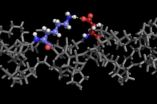(Press-News.org) Scientists from The University of Manchester were part of a European team of researchers who concluded that digital assistance for 21 of the 30 languages investigated is 'non-existent' or 'weak' at best.
The report coincides with the European Day of Languages [SEPTEMBER 26], a day which recognises the importance of fostering and developing the rich linguistic and cultural heritage of our continent.
Languages spoken by a small number of people could be at risk because they do not have technological support, the report by META-NET, a European network of excellence that consists of 60 research centres in 34 countries, including the University of Manchester's National Centre for Text Mining (NaCTeM), found.
Icelandic, Latvian, Lithuanian and Maltese are at the highest risk of disappearing, while other languages such as Bulgarian, Greek, Hungarian and Polish are also at risk. The researchers claim that 21 out of 30 European languages could become extinct in the digital world.
The study, prepared by more than 200 experts and documented in 30 volumes of the META-NET White Paper Series, assessed language technology support for each language in four different areas: automatic translation, speech interaction, text analysis and the availability of language resources.
Several languages, for example Icelandic, Latvian, Lithuanian and Maltese, receive this lowest score in all four areas.
While English has the best language technology support amongst all European languages, it can still not be considered as "excellent support", but rather only "good support", the University of Manchester researchers found in the White Paper for English.
Dutch, French, German, Italian and Spanish are considered to have "moderate support". Languages such as Basque, Bulgarian, Catalan, Greek, Hungarian and Polish exhibit "fragmentary support", which also places them in the set of high-risk languages.
Language technology software is used to process spoken or written human language. Well-known examples include spelling and grammar checkers, interactive personal assistants on smartphones (such as Siri on the iPhone), dialogue systems that work over the phone, automatic translation systems and web search engines.
The lack of available software for the high-risk languages means that without drastic action, they will be unable to survive in today's digital world.
Language technology systems primarily rely on statistical methods that require incredibly large amounts of written or spoken data - difficult to acquire for languages with relatively few speakers.
Furthermore, statistical language technology systems have inherent limits on their quality, as can be seen, for example, in the often amusing incorrect translations produced by online machine translation systems.
The report concludes that a coordinated, large-scale effort has to be made in Europe to create the missing technologies and transfer this technology to the languages faced with digital extinction .
Professor Sophia Ananiadou, director of NaCTeM, said: "In the UK, most of us use software that incorporates language technology without even realising it.
"Language technology already makes our lives easier and has huge potential to help us in many different ways. As digital information and communication is becoming increasingly dominant, it is vital that sophisticated language technology support is available for a wider range of languages, otherwise collaboration with our European neighbours will become more difficult."
Professor Hans Uszkoreit, coordinator of META-NET, said: "The results of our study are most alarming. The majority of European languages are severely under-resourced and some are almost completely neglected. In this sense, many of our languages are not yet future-proof.
### END
Most European languages in danger of digital extinction
2012-09-26
ELSE PRESS RELEASES FROM THIS DATE:
Future health risks for obese children may be greater than previously thought
2012-09-26
Research: Cardiovascular disease risk in healthy children and its association with body mass index: systematic review and meta-analysis
Editorial: Obesity in children and adolescents
Being obese as a child or adolescent may have a larger effect on future health than previously thought, suggests a study published on bmj.com today.
It comes as New York City passes a ban on large-size sugary drinks to help tackle obesity and related health problems in the US. MPs are now calling on the government to introduce similar legislation in the UK.
Researchers at the University ...
Should celebrities get involved in public health campaigns?
2012-09-26
Simon Chapman, Professor of Public Health at the University of Sydney thinks the extra publicity that celebrities provide can help promote public health. He acknowledges that celebrities are not experts but says, unlike many experts, they "often speak personally and bring compelling authenticity to public discourse."
He says those concerned about celebrities in health campaigns "invariably point to examples which have gone badly wrong or which fail to change the world forever" but argues "they are silent about the many examples of celebrity engagement that have massively ...
Medical screening for older drivers is misguided, argues senior doctor
2012-09-26
Personal View: Medical screening of older drivers is not evidence based
Medical screening of older drivers is misguided and typifies a "worrying lack of due diligence" by the medical profession, warns a senior doctor on bmj.com today.
Professor Desmond O'Neill, Consultant Physician in Geriatric and Stroke Medicine at Trinity College Dublin, argues that older drivers not only have an enviable crash record, but they also raise traffic safety among other generations: the risk of serious injury to children is halved if driven by grandparents rather than parents. "Yet the ...
Backpack-toting birds help UBC researchers reveal migratory divide, conservation hotspots
2012-09-26
By outfitting two British Columbia subspecies of Swainson's thrushes with penny-sized, state-of-the-art geolocators, University of British Columbia researchers have been able to map their wildly divergent migration routes and pinpoint conservation hotspots.
"Birds of a feather do not necessarily flock together," says Kira Delmore, a PhD student with UBC's Department of Zoology and lead author of the paper. "Our teams of thrushes took dramatically different routes to get to their wintering grounds, either south along the west coast to Central America, or southeast to Alabama ...
Doctors' 'gut feeling' should not be ignored
2012-09-26
Doctors who experience a gut feeling about serious illness when treating a child in primary care should take action upon this feeling and not ignore it, a study published today on bmj.com suggests.
Serious infection can easily be missed in young children and making a diagnosis has been described as "like finding a needle in a haystack". A clinician's intuitive feeling that something is wrong, even after examination that suggests otherwise, appears to have diagnostic value, even greater diagnostic value than most symptoms and signs. Studies have suggested it should be ...
Rice University lab encodes collagen
2012-09-26
HOUSTON – (Sept. 25, 2012) – The human body is proficient at making collagen. And human laboratories are getting better at it all the time.
In a development that could lead to better drug design and new treatments for disease, Rice University researchers have made a major step toward synthesizing custom collagen. Rice scientists who have learned how to make collagen – the fibrous protein that binds cells together into organs and tissues – are now digging into its molecular structure to see how it forms and interacts with biological systems.
Jeffrey Hartgerink, an associate ...
Hubble goes to the 'eXtreme' to assemble the deepest ever view of the universe
2012-09-26
The Hubble Ultra Deep Field is an image of a small area of space in the constellation of Fornax (The Furnace), created using Hubble Space Telescope data from 2003 and 2004. By collecting faint light over one million seconds of observation, the resulting image revealed thousands of galaxies, both nearby and very distant, making it the deepest image of the Universe ever taken at that time.
The new full-colour XDF image is even more sensitive than the original Hubble Ultra Deep Field image, thanks to the additional observations, and contains about 5500 galaxies, even within ...
Oropharyngeal cancer patients with HPV have a more robust response to radiation therapy
2012-09-26
(SACRAMENTO, Calif.) — UC Davis cancer researchers have discovered significant differences in radiation-therapy response among patients with oropharyngeal cancer depending on whether they carry the human papillomavirus (HPV), a common sexually transmitted virus. The findings, published online today in The Laryngoscope Journal, could lead to more individualized radiation treatment regimens, which for many patients with HPV could be shorter and potentially less toxic.
HPV-related cancers of the oropharynx (the region of the throat between the soft palate and the epiglottis, ...
Images reveal potential for NIR imaging to detect success of breast reconstruction
2012-09-26
In 2010 breast reconstruction entered the Top Five list of reconstructive procedures in the US, with 93,000 procedures performed, up 8% from 2009, and 18% from 2000. This is among the most common skin flap procedure performed.
Skin flaps are typically used to cover areas of tissue loss or defects that arise as a result of traumatic injury, reconstruction after cancer excision and repair of congenital defects. In the case of a mastectomy—the surgical removal of the breast—skin flaps are commonly used to create a new breast. Most commonly these flaps are derived from the ...
Hotter might be better at energy-intensive data centers
2012-09-26
As data centres continue to come under scrutiny for the amount of energy they use, researchers at University of Toronto Scarborough (UTSC) have a suggestion: turn the air conditioning down.
"We see our results as strong evidence that most organizations could run their data centers hotter than they currently are without making significant sacrifices in system reliability," says Bianca Schroeder, a UTSC assistant professor of computer science.
As data centres have proliferated they have required more energy, accounting now for about 1 percent of global electricity usage. ...

